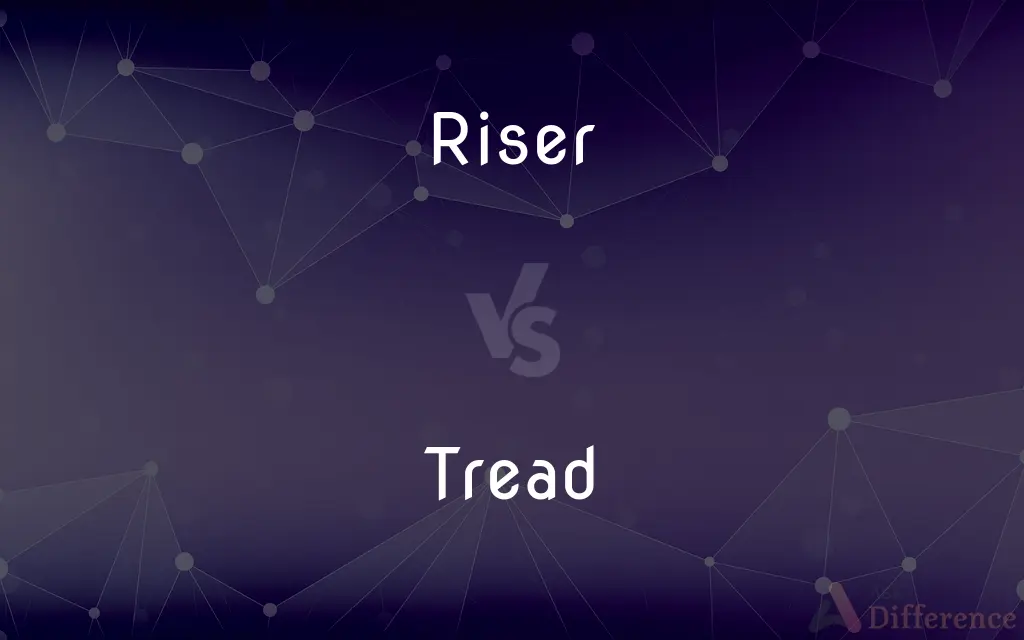Riser vs. Tread — What's the Difference?
By Maham Liaqat & Fiza Rafique — Updated on April 5, 2024
A riser is the vertical component between each tread in a staircase, affecting the step's height, while a tread is the horizontal part that is stepped on, determining step depth.

Difference Between Riser and Tread
Table of Contents
ADVERTISEMENT
Key Differences
Risers are the vertical sections between the steps of a staircase, dictating the height of each step. Whereas treads are the horizontal surfaces of the stairs where the foot is placed, influencing the safety and comfort of the staircase.
Risers can be either open (without a back, allowing for visibility and light pass-through) or closed (with a vertical board between treads, offering more safety). On the other hand, treads must be solid to support weight, often having a non-slip surface for safety.
The height of risers impacts the steepness of the staircase; lower risers result in a less steep climb, making them more accessible for different users. While the depth of treads affects the ease of use of the stairs, with deeper treads providing more space for footing and a more comfortable ascent or descent.
In terms of design, risers offer an opportunity to add aesthetic elements to a staircase, such as decorative patterns or lighting. Treads, however, are focused more on functionality, though they too can be designed with aesthetics in mind, using different materials or finishes.
Risers contribute to the overall vertical height of the staircase, which must be considered in building design for proper ceiling clearance. Treads contribute to the staircase's horizontal length, requiring space planning in floor layouts.
ADVERTISEMENT
Comparison Chart
Position
Vertical component between steps
Horizontal component where foot is placed
Function
Dictates step height, affects staircase slope
Provides surface for stepping, affects depth
Design
Can be open or closed, affects aesthetics
Material choice affects safety and aesthetics
Safety
Closed risers prevent tripping
Non-slip surface enhances safety
Accessibility
Lower risers make stairs less steep
Deeper treads offer more secure footing
Compare with Definitions
Riser
A riser is the vertical part between each step in a staircase.
The staircase's design featured wooden risers that matched the balustrade.
Tread
A tread is the horizontal part of a staircase designed for foot placement.
The stone treads were polished to a high shine.
Riser
In open riser staircases, the absence of a riser creates a visually lighter structure.
The open risers gave the staircase a modern, airy feel.
Tread
Non-slip treads are essential for stair safety, especially in public spaces.
Non-slip strips were added to each tread for safety.
Riser
Risers can feature decorative elements for added aesthetic.
The painted risers added a unique charm to the classic staircase.
Tread
The choice of tread material can significantly affect the staircase's look and feel.
Hardwood treads brought warmth to the room's décor.
Riser
Risers can determine the staircase's steepness.
Choosing a lower riser height made the stairs easier to climb.
Tread
Tread depth is a critical design consideration for comfort and accessibility.
The generous tread depth made the staircase comfortable for all users.
Riser
The height of the riser is key to ensuring staircase safety and compliance with building codes.
The building inspector checked the riser heights for uniformity.
Tread
Treads must be deep enough to allow for safe foot placement.
The wide treads accommodated even large footwear comfortably.
Riser
One who rises, especially from sleep
A late riser.
Tread
To walk on, over, or along
Tread the pavement.
Riser
The vertical part of a stair step.
Tread
To press beneath the feet; trample
Dirt that was trodden into the rug.
Riser
A platform, as for elevating a group of people above a crowd, often arranged with similar platforms in tiers.
Tread
To treat unjustly or harshly; oppress
People who were trodden down by tyrants.
Riser
Someone or something which rises.
Tread
To form by walking or trampling
Tread a path.
Riser
A platform or stand used to lift or elevate something.
The choir stood on risers for the performance.
Tread
To execute by walking or dancing
Tread a measure.
Riser
The vertical part of a step on a staircase.
Tread
To copulate with. Used of a male bird.
Riser
(archery) The main body of a bow.
Tread
To go on foot; walk.
Riser
A vertical utility conduit, pipe or path between floors of a building for placement of cables (e.g. telephone, networking), or to convey fluids (e.g. gas, water).
Tread
To set down the foot; step.
Riser
A pipe connecting an individual exhaust port of an internal combustion engine to the muffler, particularly on aircraft.
Tread
To trample something. Used with on or upon
Don't tread on the new grass.
Riser
A Manx cat with a showable short tail.
Tread
To treat someone or something unjustly or harshly. Used with on or upon
A regime treading upon the rights of the citizens.
Riser
A strip of webbing joining a parachute's harness to the rigging lines.
Tread
To copulate. Used of birds.
Riser
A reservoir built into a metal casting mold to prevent the formation of cavities in the casting as the metal shrinks on cooling.
Tread
The act, manner, or sound of treading.
Riser
One who rises; as, an early riser.
Tread
An instance of treading; a step.
Riser
The upright piece of a step, from tread to tread.
Tread
A mark made by treading, as in snow.
Riser
A shaft excavated from below upward.
Tread
The upper horizontal part of a step in a staircase.
Riser
A person who rises (especially from bed);
He's usually a late riser
Tread
The part of a wheel or tire that makes contact with the road or rails.
Riser
A vertical pipe in a building
Tread
The grooved face of a tire.
Riser
Structural member consisting of the vertical part of a stair or step
Tread
The part of a shoe sole that touches the ground.
Tread
Either of the continuous ridged belts with which bulldozers, tanks, and certain other vehicles move over the ground.
Tread
(intransitive) To step or walk (on or across something); to trample.
He trod back and forth wearily.
Don't tread on the lawn.
Tread
(transitive) To step or walk upon.
Actors tread the boards.
Tread
To proceed, to behave (in a certain manner).
To tread lightly, to tread gently
To tread carefully, to tread cautiously, to tread warily
Tread
To beat or press with the feet.
To tread a path; to tread land when too light; a well-trodden path
Tread
To work a lever, treadle, etc., with the foot or the feet.
Tread
To go through or accomplish by walking, dancing, etc.
Tread
To crush under the foot; to trample in contempt or hatred; to subdue.
Tread
(intransitive) To copulate; said of (especially male) birds.
Tread
To copulate with.
Tread
(transitive) To crush grapes with one's feet to make wine
Tread
A step taken with the foot.
Tread
A manner of stepping.
Tread
The sound made when someone or something is walking.
Tread
(obsolete) A way; a track or path.
Tread
The horizontal part of a step in a flight of stairs.
Tread
The grooves carved into the face of a tire, used to give the tire traction.
Tread
The grooves on the bottom of a shoe or other footwear, used to give grip or traction.
Tread
(biology) The chalaza of a bird's egg; the treadle.
Tread
The act of avian copulation in which the male bird mounts the female by standing on her back.
Tread
(fortification) The top of the banquette, on which soldiers stand to fire over the parapet.
Tread
A bruise or abrasion produced on the foot or ankle of a horse that interferes, or strikes its feet together.
Tread
To set the foot; to step.
Where'er you tread, the blushing flowers shall rise.
Fools rush in where angels fear to tread.
The hard stoneUnder our feet, on which we tread and go.
Tread
To walk or go; especially, to walk with a stately or a cautious step.
Ye that . . . stately tread, or lowly creep.
Tread
To copulate; said of birds, esp. the males.
One woe doth tread upon another's heel.
Tread
To step or walk on.
Forbid to tread the promised land he saw.
Methought she trod the ground with greater grace.
Tread
To beat or press with the feet; as, to tread a path; to tread land when too light; a well-trodden path.
Tread
To go through or accomplish by walking, dancing, or the like.
They have measured many a mile,To tread a measure with you on this grass.
Tread
To crush under the foot; to trample in contempt or hatred; to subdue.
Through thy name will we tread them under that rise up against us.
Tread
To copulate with; to feather; to cover; - said of the male bird.
Tread
A step or stepping; pressure with the foot; a footstep; as, a nimble tread; a cautious tread.
She is coming, my own, my sweet;Were it ever so airy a tread,My heart would hear her and beat.
Tread
Manner or style of stepping; action; gait; as, the horse has a good tread.
Tread
Way; track; path.
Tread
The act of copulation in birds.
Tread
The upper horizontal part of a step, on which the foot is placed.
Tread
The top of the banquette, on which soldiers stand to fire over the parapet.
Tread
The part of a wheel that bears upon the road or rail.
Tread
The chalaza of a bird's egg; the treadle.
Tread
A bruise or abrasion produced on the foot or ankle of a horse that interferes. See Interfere, 3.
Tread
A step in walking or running
Tread
The grooved surface of a pneumatic tire
Tread
The part (as of a wheel or shoe) that makes contact with the ground
Tread
Structural member consisting of the horizontal part of a stair or step
Tread
Put down or press the foot, place the foot;
For fools rush in where angels fear to tread
Step on the brake
Tread
Tread or stomp heavily or roughly;
The soldiers trampled across the fields
Tread
Crush as if by treading on;
Tread grapes to make wine
Tread
Brace (an archer's bow) by pressing the foot against the center
Tread
Apply (the tread) to a tire
Tread
Mate with;
Male birds tread the females
Common Curiosities
What is a tread in a staircase?
A tread is the horizontal part of a staircase step where a person places their foot.
What is a riser in a staircase?
A riser is the vertical component between the steps of a staircase, contributing to the step's height.
Why are treads important for stair safety?
Treads provide the surface for stepping, where their depth and any non-slip treatments are critical for safety.
Can a staircase have no risers?
Yes, staircases can have open risers, where the space between treads is unoccupied, creating a more open look.
How do risers affect staircase design?
Risers influence the staircase's steepness and safety, and can be designed to add aesthetic value.
How do building codes affect riser height?
Building codes specify maximum and minimum riser heights to ensure safety and accessibility.
How does tread depth impact stair use?
Deeper treads offer more room for footing, making stairs easier and safer to use.
Can the material of a tread affect its safety?
Yes, the material's texture and finish can influence the tread's slip resistance and overall safety.
What’s the difference between open and closed risers?
Open risers lack the vertical board between treads, while closed risers have it, affecting visibility and safety.
Can risers be decorative?
Yes, risers can be painted, patterned, or otherwise designed to add decorative elements to a staircase.
What materials are used for treads?
Treads can be made from wood, stone, metal, or other materials, depending on the staircase's design and requirements.
Do risers and treads need to match in material?
While not a requirement, matching risers and treads can create a cohesive aesthetic for the staircase.
How does the absence of a riser impact a staircase’s design?
The absence of a riser (open riser design) can make a staircase appear more open and modern but may not be suitable for all spaces.
Is it better to have open or closed risers?
The choice between open and closed risers depends on design preferences and safety considerations, with closed risers generally being safer.
What are some common treatments to enhance tread safety?
Non-slip strips, mats, or coatings can be applied to treads to enhance safety by reducing the risk of slipping.
Share Your Discovery

Previous Comparison
Massa vs. Master
Next Comparison
Backward vs. ForwardAuthor Spotlight
Written by
Maham LiaqatCo-written by
Fiza RafiqueFiza Rafique is a skilled content writer at AskDifference.com, where she meticulously refines and enhances written pieces. Drawing from her vast editorial expertise, Fiza ensures clarity, accuracy, and precision in every article. Passionate about language, she continually seeks to elevate the quality of content for readers worldwide.















































